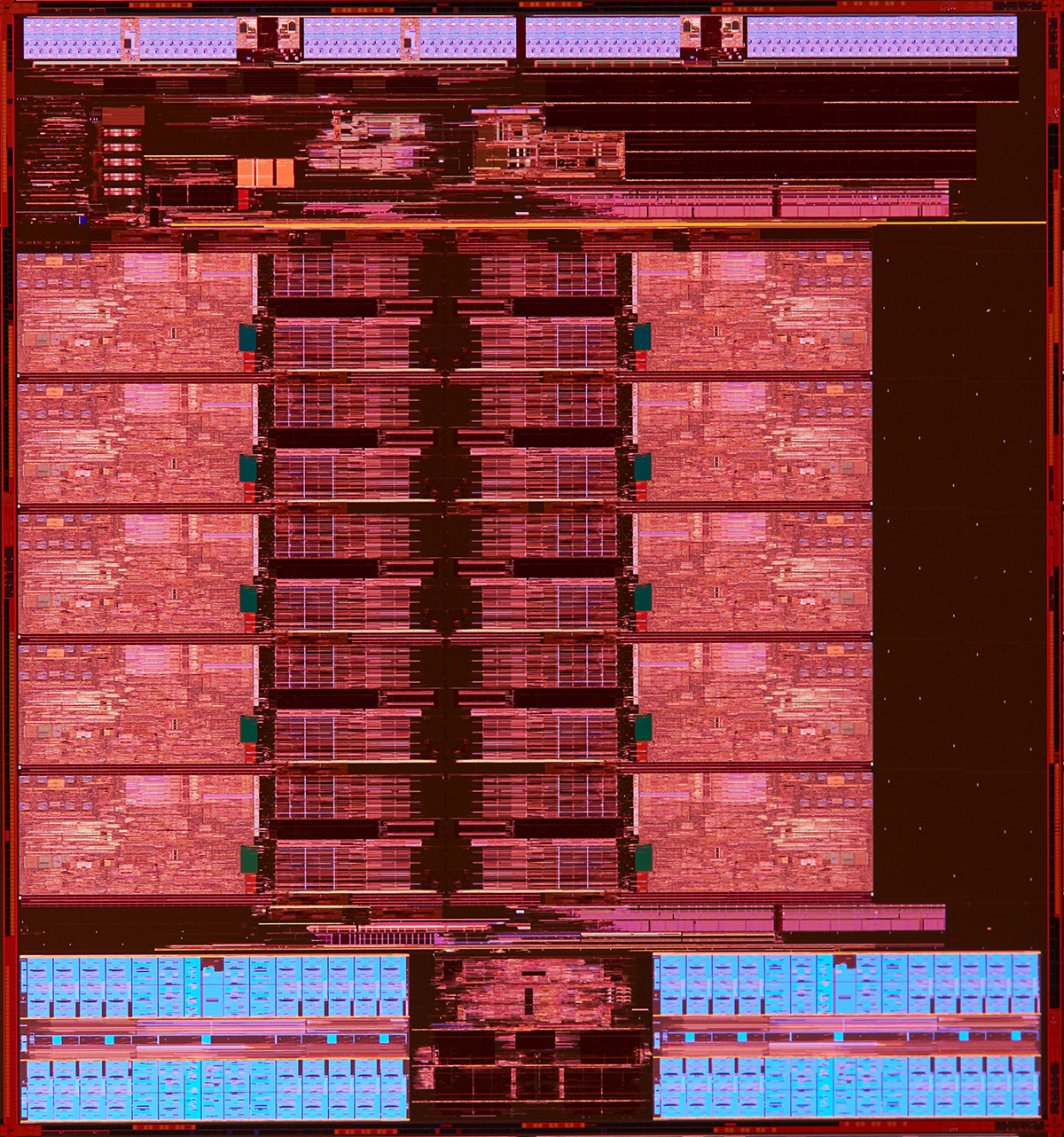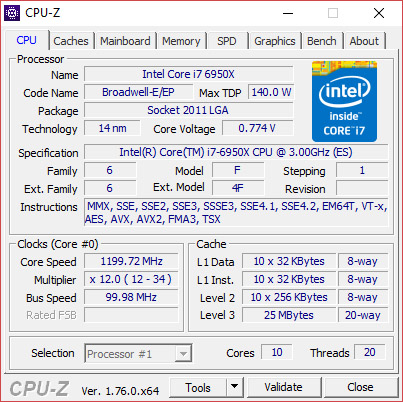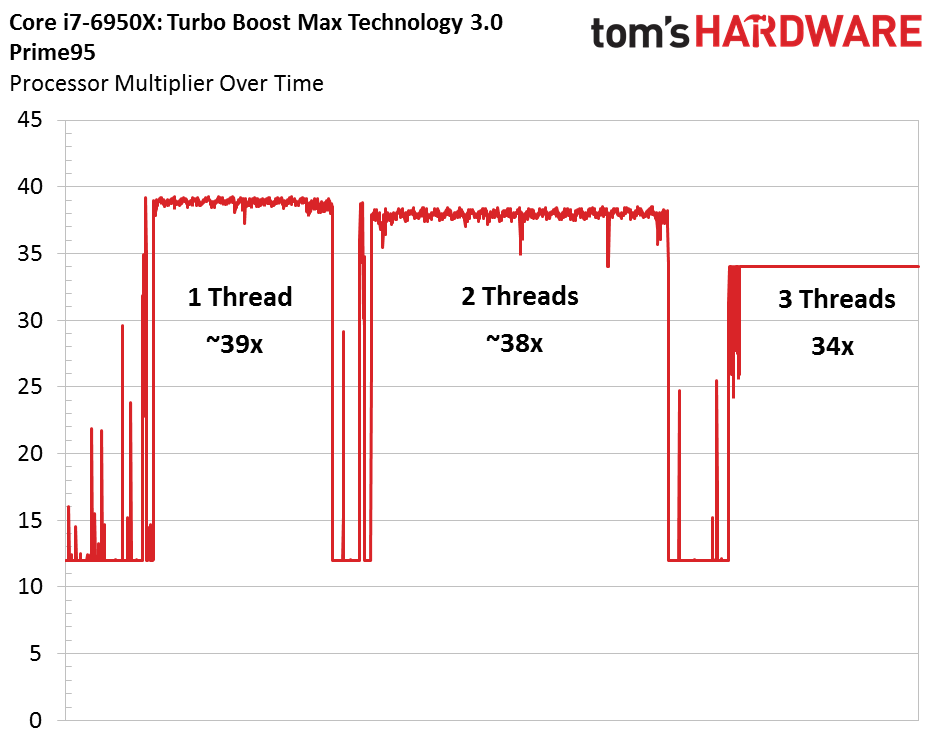Broadwell-E: Intel Core i7-6950X, 6900K, 6850K & 6800K Review
Is Broadwell more attractive to enthusiasts without graphics and up to 10 Hyper-Threaded cores? We test against two previous generations, plus Skylake to find out.
Meet Broadwell-E For The High-End Desktop
Intel launched its sixth-gen Core architecture, code-named Skylake, last August. That design’s predecessor, referred to as Broadwell, surfaced on the desktop two months prior. I can’t remember a time in the company’s history that an entire product family was superseded so quickly.
The Broadwell-based Core i7-577C and Core i5-5675C weren’t inherently flawed or anything. But they also weren’t optimally configured to replace Intel’s popular Devil’s Canyon CPUs, which enthusiasts bought up in hopes of pushing the Haswell architecture to 5GHz. Instead of emphasizing host processing performance, the Broadwell-based chips we reviewed last June put graphics first. Their Iris Pro Graphics 6200 engines served up playable frame rates in many popular games at 1920x1080, decimating AMD’s fastest APUs in the process. But with IA cores running at lower clock rates than the Core i7-4790K and Core i5-4690K, Broadwell often underperformed in our benchmark suite. No wonder Intel wasted little time rolling out Skylake.
| Processor Family Introductions | |||
|---|---|---|---|
| Architecture | Desktop | Enthusiast/Workstation | Difference in Months |
| Sandy Bridge | January 2011 | November 2011 | 10 |
| Ivy Bridge | April 2012 | September 2013 | 16 |
| Haswell | June 2013 | August 2014 | 15 |
| Broadwell | June 2015 | June 2016 | 13 |
| Skylake | August 2015 | TBD | Row 5 - Cell 3 |
We always knew we’d be seeing Broadwell again, though. There’s a fairly predictable lag between when Intel rolls out a new architecture and when the design is adapted for server/workstation use. So, when we got our hands on Xeon E5-2600 v4, based on Broadwell-EP, we knew the single-socket version for enthusiasts and workstations wasn’t far behind.
Today’s Broadwell-E launch sees Intel’s high-end portfolio expand by 33%. Instead of three new models, we’re getting four. The flagship is now a $1723 affair, rather than the ~$1000 we’re accustomed to paying. But we don’t expect that to be the model most power users express interest in. Let’s break Broadwell-E down to determine if it makes sense as an upgrade to Haswell-E in the latest LGA 2011-v3 platforms.

Broadwell-E, Hold the Graphics, Please
As Intel’s mainstream processors evolve, more of their transistors are dedicated to graphics. The impetus is easy to understand. Its IA cores are tuned well. Four of them working in parallel offer a reasonable balance—fewer cores would bottleneck intensive desktop workloads, while more would go underutilized. Graphics, on the other hand, is an inherently parallel problem. Intel could keep dumping execution units into its graphics engine and still trail the fastest discrete GPUs.

Increasingly, the average desktop user can drop a Skylake-based CPU into an affordable motherboard and enjoy great performance in most applications, even games. Those of us who purpose-build our PCs for gaming bypass on-die graphics, though. We need add-in cards designed for high resolutions and fast frame rates. As a result, much of the progress Intel makes from one generation to the next goes to waste. And enthusiasts don’t like waste.
Whereas the desktop Broadwell launch was a showcase of Intel’s 14nm tri-gate transistors and unprecedented graphics capabilities, Broadwell-E puts the emphasis back on host processing. Customers at this end of the spectrum install their own graphics cards, network adapters and storage controllers to maximize performance. They need lots of connectivity, not passable integrated extras. And so Broadwell-E continues a tradition of increasing core count, piling on cache, feeding on-die resources with a beefier memory controller and expanding PCI Express to accommodate more peripherals.
Get Tom's Hardware's best news and in-depth reviews, straight to your inbox.
All four Broadwell-E-based models—Core i7-6950X, Core i7-6900K, Core i7-6850K and Core i7-6800K—are derived from a single die configuration composed of ~3.2 billion transistors.
| Header Cell - Column 0 | Core i7-6950X | Core i7-6900K | Core i7-6850K | Core i7-6800K |
|---|---|---|---|---|
| Base Clock Rate | 3.0GHz | 3.2GHz | 3.6GHz | 3.4GHz |
| Max. Turbo Boost Freq. | 3.5GHz | 3.7GHz | 3.8GHz | 3.6GHz |
| Cores/Threads | 10/20 | 8/16 | 6/12 | 6/12 |
| Shared L3 Cache | 25MB | 20MB | 15MB | 15MB |
| PCIe 3.0 Lanes | 40 | 40 | 40 | 28 |
| Memory Support | DDR4-2400 | DDR4-2400 | DDR4-2400 | DDR4-2400 |
| TDP | 140W> | 140W | 140W | 140W |
| Interface | LGA 2011-v3 | LGA 2011-v3 | LGA 2011-v3 | LGA 2011-v3 |
| Price | $1723 | $1089 | $617 | $434 |
The flagship -6950X features 10 cores, representing the complete LCC die. Each core is associated with 2.5MB of last-level cache, yielding a 25MB pool across the chip. The cores also have their own 32KB L1 instruction and data caches, plus 256KB of L2 cache. Core i7-6950X operates at a base frequency of 3GHz, but ramps up to 3.5GHz through Turbo Boost. From there, Intel adds a familiar 40-lane PCIe 3.0 controller and a quad-channel DDR4 controller, which steps up from 2133 MT/s memory support to data rates as high as 2400 MT/s. Hyper-Threading support up and down the Core i7 family means -6950X works on up to 20 threads concurrently.

Despite the changes, Broadwell-E is still compatible with Intel’s X99 chipset through an LGA 2011-v3 interface. Existing motherboards should receive firmware updates to properly recognize the processor family. Meanwhile, new models like the MSI X99A Gaming Pro Carbon we’re testing with today modernize Intel’s aging platform to give it USB 3.1 Gen 2 support, Type-C port connectivity and a U.2 connector for high-end storage.
It’s notable that -6950X maintains the same base and peak clock rates as its predecessor, -5960X, with an extra two cores and the same 140W TDP. No doubt this is attributable to the shift from 22 to 14nm manufacturing.
Those extra two cores compared to Core i7-5960X cost you dearly, unfortunately. Whereas the top Haswell-E model sold for $1000, Intel wants $1723 for Core i7-6950X.
One step down, Core i7-6900K gives you the same eight cores as Intel’s Core i7-5960X at a marginally higher $1089 price point. Disabling two of the die’s cores also turns off 5MB of shared L3 cache; similar to the -5960X, Intel’s Core i7-6900K includes 20MB total. Beyond the speed-up that comes from Broadwell’s slight IPC advantage over Haswell, -6900K also sports a 200MHz-faster base clock rate of 3.2GHz and a maximum Turbo Boost frequency of 3.7GHz. PCIe connectivity goes unchanged from the -6950X, as does memory support, TDP and X99 compatibility.
More About Broadwell
We've covered Intel's Broadwell architecture in a number of previous stories, including Introducing Intel's 14nm Node and the Broadwell Processor, Broadwell: Intel Core i7-5775C And i5-5675C Review and most recently Intel Xeon E5-2600 v4 Broadwell-EP Review.
The Core i7-6850K features six Hyper-Threaded cores and 15MB of last-level cache, allowing it to juggle 12 threads at a time. Fewer active cores give Intel the thermal headroom to play with clock rates a bit, and the -6850’s base frequency increases to 3.6GHz (a 100MHz advantage over Core i7-5930K). Turbo Boost takes the CPU to 3.8GHz in lightly-threaded workloads (also a 100MHz increase compared to the previous generation).
This is the third and final Broadwell-E CPU with 40 lanes of PCIe connectivity. DDR4-2400 memory support carries over, as does the 140W TDP and LGA 2011-v3 interface. Not surprisingly, Intel targets a similar price as the -6850K’s predecessor, citing $617 in 1000-unit quantities.
Also a six-core processor, Core i7-6800K operates at a diminished 3.4GHz base and 3.6GHz maximum Turbo Boost frequency. Its 15MB of shared L3 cache, four channels of DDR4-2400 memory support, 140W TDP and LGA 2011-v3 interface go unchanged from the -6850K. However, its PCI Express controller narrows to 28 lanes.
With the recent revelation that SLI support on Nvidia’s Pascal-based cards is officially limited to dual-GPU configurations, not to mention data showing little performance difference between x8 and x16 links, the loss of 12 lanes compared to Intel’s higher-end Core i7s shouldn’t be a deal-breaker. Twenty-eight lanes are enough for two high-end GPUs, PCIe-based storage and even add-in networking if you need it. The real question is going to be whether you’re better off with six Broadwell cores at 3.4GHz or four Skylake cores at 4GHz (for $100 less, at that).
Turbo Boost 3.0: Broadwell-E’s Innovative Extra
Although it’s hard to fall in love with Broadwell-E’s specifications and downright difficult to forgive an almost doubling in price of the top-end model, today’s launch does introduce one new feature enthusiasts may appreciate (if we're able to get to the bottom of what it does).
Subtle variations in the quality of a silicon die, determined by many different variables in the manufacturing process, affect a CPU’s maximum frequency at any given voltage level. Even within a single CPU, it’s common to find one core that runs cooler or overclocks further than the others when they’re all subject to a similar workload.
According to Intel, its Turbo Boost Max Technology 3.0 gives you the ability to characterize a CPU’s performance via software, identify the strongest core and run single-threaded workloads on it. The idea is to maximize the amount of time you spend at high frequencies, scaling down as core utilization increases. It either requires OS awareness or Intel’s core affinitization driver; we used the latter on our Windows 10-based test benches. Intel doesn’t consider this overclocking, as the CPU continues to operate within its specifications.

This capability is enabled across all four Broadwell-E processors for now. Intel couldn’t tell us whether there’s any hardware on-die needed to support Turbo Boost Max Technology 3.0, but motherboard BIOS support is required. We wouldn't be surprised to see this functionality make its way into the next generation of mainstream processors as well.
Turbo Boost Max does not take the place of Turbo Boost 2.0—that feature continues to increase clock rate up to predetermined limit based on core utilization. Rather, Turbo Boost Max appears to pin affinity to the “fastest” core and actually exceed that ceiling. The trick is it can be difficult to spot. There's a Utilization Threshold percentage that must be crossed during an Evaluation Interval, which assures Turbo Boost Max kicks in to help with demanding work. By default, the threshold is 90% and the interval is 1000ms. Our single-threaded LAME benchmark never hits 90%, so as we were looking for Turbo Boost Max in that real-world test, we never saw frequencies above 3.4GHz (within the -6950X's Turbo Boost 2.0 range). Cinebench's single-core benchmark tops out at 99.5% utilization on one core though, so it stretches all the way up to 4GHz according to ThrottleStop 8.10 Beta 2.

There's naturally a limit to where Turbo Boost Max Technology 3.0 can no longer provide its benefit. In the graph above, we ran Prime95's torture test with one thread active, turned it off, increased to two threads, turned it off and then fired up three threads. The first pass gave us 3.9GHz before dropping back to an EIST-imposed 1.2GHz. Next, we saw 3.8GHz. By the time three threads were active, the Core i7-6950X was pegged at 3.4GHz.
Intel could probably do a better job documenting this feature, but we're not sure if it's guaranteeing up to 4GHz on a -6950X through Turbo Boost Max Technology 3.0 or simply telling enthusiasts they can expect some arbitrary degree of additional performance based on the quality of their CPU.
MORE: Best CPUs
MORE: All CPU Content
MORE: Intel & AMD Processor Hierarchy
Current page: Meet Broadwell-E For The High-End Desktop
Next Page Test Setup & Overclocking-
jt AJ was expecting a bit more info and review usage of turbo 3.0. also looks like most of broadwell E chip is junk.. except that one 6850k chip you received probably lucky 1.25v for 4.4v would be good thats only because its broadwell. got one here for 4.8ghz at just 1.22v.Reply -
Nuckles_56 Chris, how likely is it that a noctua NH-D15 would be able to cool these heat producing monsters if your h100i struggled and failed with the i7-6800k @4.4GHz.Reply
But a truly excellent review, even if it does show that there is little reason to go to broadwell-E over Haswell-E -
elho_cid I'd love to step up to the realm of higher core count, but given the results of Adobe SW when scaling to many threads, meas it is not really useful right now. :/Reply
That's a pity, because the most time I spend staring at a progress bar is when I'm using Adobe products. I don't really need more power to "background tasks" like zipping or lame encoding.
-
AdmiralDonut Standard SLI is not limited on the new NVIDIA cards. The only thing that's limited is the new High Bandwidth SLI. Normal 3 and 4-way SLI can be enabled easily by simply asking NVIDIA for an unlock code, something any half way serious enthusiast will most certainly do. Here's some more info on this matter:Reply
https://www.youtube.com/watch?v=2wBDt9tN5-c -
bit_user I don't really see the point of having a $1700 non-Xeon SKU. Of the few people who can afford it, even less would bother/dare to overclock it.Reply
I'm still wishing for the rumored 5 GHz SKU to surface. I've rarely needed more than 4 cores, but a couple extra GHz always comes in handy. Even so, I'll not be upgrading until at least Skylake-E or perhaps Kaby-E.
-
Cerunnir ReplyChris, how likely is it that a noctua NH-D15 would be able to cool these heat producing monsters if your h100i struggled and failed with the i7-6800k @4.4GHz.
But a truly excellent review, even if it does show that there is little reason to go to broadwell-E over Haswell-E
NH-D15 is arguably better or atleast equal to the H100i when it comes to cooling, and its noise levels is definatly lower both in load and while idle.
http://www.relaxedtech.com/reviews/noctua/nh-d15-versus-closed-loop-liquid-coolers/2 -
bit_user Reply
No. Buy a Xeon version, for that. It's practically the only difference. It's artificial product differentiation, known as "market segmentation".18045773 said:Does it have support for ECC ram?
Here, you can find links to the specs of the CPUs mentioned in this article: http://ark.intel.com/products/family/79318/Intel-High-End-Desktop-Processors#@Desktop If you view their individual specs, you can see that none support ECC.
Intel hasn't yet announced the E5-16xx v4 series CPUs, but you can turn up leaked specs with a bit of searching.
And you'll need motherboard support, too.
-
cats_Paw Good review (excellent if its only the heads up for a more in-depth one).Reply
I have to say that I would love to have a 6 or even 8 core CPU but these prices and performances dont add up.
In my country a 6700K and a 5820K are priced almost the same, but its still a hard choice (Do i want a "maybe" future proof 6 core that can be good for some work or a 4 core that is flat out faster and cheaper to build around for gaming?). -
pyoverdin Am I correct in saying I could build a PC that's 5 FPS off the 6950X for it's price?Reply
